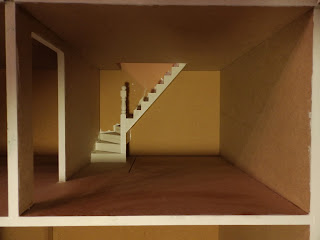In the living room I began by painting the ceiling with the same white silk emulsion I had used in the kitchen. When I first put my house together I'd originally painted the banister and staircase white but this didn't look quite right now somehow. In my research I discovered that brown was a popular choice for staircases in the 1930s and 40s so brown it was! I didn't have a brown coloured paint so I mixed my own brown colour using the colours I did have - scarlet red, ochre yellow, olive green and black acrylic paint which gave me just the right colour I was looking for. I was very pleased with the results - very retro!
I then looked at my room and realised it needed a focal point. There was no chimney breast wall (as both chimneys are on the side of the house) in the centre of the room to make the fireplace the main feature so I decided to create my own. My Grandad used to have a wonderful Art Deco tiled fireplace in his living room and I wanted to create the same look. To construct my wall I used a box made of very strong cardboard and cut it down to the size I wanted. I then covered it using the cardboard from the back of a writing pad to make the shape neater and more sturdy. I glued the box and fixed it to the wall then I left it to dry. For my living room wallpaper I used the 'Roman Swag' Art Deco wallpaper from the Dolls House Emporium. I measured the lengths I needed making sure that all the pieces would match when it was hung on the wall and I glued my paper to the wall using ordinary wallpaper paste. I painted the back of the paper using a medium sized paintbrush and starting at the left hand corner of the back wall I begun hanging it piece by piece. I smoothed out any bumps and bubbles along the way using a dry, scrunched up piece of kitchen roll. I left the left side wall until last. That was the part I was least looking forward to doing as I'd already glued the banister to the wall! Ooops! To paper this bit I measured, cut and hung a piece which stopped just short of the hand rail. Next I cut another piece roughly 2 inches wide to piece around the banister. I measured where the banister came to and made a vertical cut up the paper (slightly higher than the height of the banister) then made cuts at 12, 1, 3, 5, 6, 7, 9 and 11 o' clock so I had what looked a bit like a fairy wand shape in the wallpaper (see picture below).
Once I'd done this I pasted the paper and attached it around the banister smoothing it down so there were no gaps or mismatched pieces in the paper. Finally I pasted the last piece and attached it to the wall, again making sure the wallpaper matched. Once the paper had fully dried I cut the ragged pieces around the banister using a sharp Stanley knife. I'm planning on putting coving at the top of my walls and skirting boards at the bottom so I am not too bothered that the edges of my wallpaper aren't perfect. This is what the room looks like fully papered..
Next for this room I need to decide on what type of flooring to have and at the moment I'm thinking painted/ varnished floorboards with a nice little rug in front of the fire. I've already seen the perfect fireplace just like my Grandad's which is from Hearth and Home Miniatures. It is pretty expensive but I think it'll look amazing. Here it is..
























